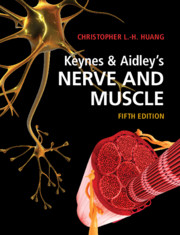Book contents
- Keynes & Aidley’s Nerve and Muscle
- Keynes & Aidley’s Nerve and Muscle
- Copyright page
- Dedication
- Contents
- Preface
- Acknowledgements
- Abbreviations used in the text
- 1 Structural Organisation of the Nervous System
- 2 Resting and Action Potentials
- 3 Background Ionic Homeostasis of Excitable Cells
- 4 Membrane Permeability Changes During Excitation
- 5 Voltage-Gated Ion Channels
- 6 Cable Theory and Saltatory Conduction
- 7 Neuromuscular Transmission
- 8 Synaptic Transmission in the Nervous System
- 9 The Mechanism of Contraction in Skeletal Muscle
- 10 The Activation of Skeletal Muscle
- 11 Excitation–Contraction Coupling in Skeletal Muscle
- 12 Contractile Function in Skeletal Muscle
- 13 Cardiac Muscle
- 14 Ion Channel Function and Cardiac Arrhythmogenesis
- 15 Smooth Muscle
- Further Reading
- References
- Index
2 - Resting and Action Potentials
Published online by Cambridge University Press: 07 November 2020
- Keynes & Aidley’s Nerve and Muscle
- Keynes & Aidley’s Nerve and Muscle
- Copyright page
- Dedication
- Contents
- Preface
- Acknowledgements
- Abbreviations used in the text
- 1 Structural Organisation of the Nervous System
- 2 Resting and Action Potentials
- 3 Background Ionic Homeostasis of Excitable Cells
- 4 Membrane Permeability Changes During Excitation
- 5 Voltage-Gated Ion Channels
- 6 Cable Theory and Saltatory Conduction
- 7 Neuromuscular Transmission
- 8 Synaptic Transmission in the Nervous System
- 9 The Mechanism of Contraction in Skeletal Muscle
- 10 The Activation of Skeletal Muscle
- 11 Excitation–Contraction Coupling in Skeletal Muscle
- 12 Contractile Function in Skeletal Muscle
- 13 Cardiac Muscle
- 14 Ion Channel Function and Cardiac Arrhythmogenesis
- 15 Smooth Muscle
- Further Reading
- References
- Index
Summary
Studies demonstrating, characterising and thereby clarifying our understanding of nerve function began from the experimental availability of electophysiological methods for recording and stimulation of bio-electric signals. The classical recording methods were developed to measure intracellular potentials directly from cephalopod giant axons, skeletal muscle fibres and other excitable cell types. These consistently demonstrated strongly negative resting potentials and monophasic action potentials in response to stimulation, whose detailed waveforms varied with different excitable tissue types through a wide range of species. Measurement of extracellular potential differences between different recording sites in the nervous system permitted study both of electrical events occurring at a point, and their propagation along lengths of nerve. This demonstrated and characterised the observed compound action potentials. It separated their components by conduction velocity attributing this to their different fibre diameters and degrees of myelination. It also demonstrated their threshold excitation, all-or-none and refractoriness properties.
Keywords
- Type
- Chapter
- Information
- Keynes & Aidley's Nerve and Muscle , pp. 10 - 21Publisher: Cambridge University PressPrint publication year: 2020



